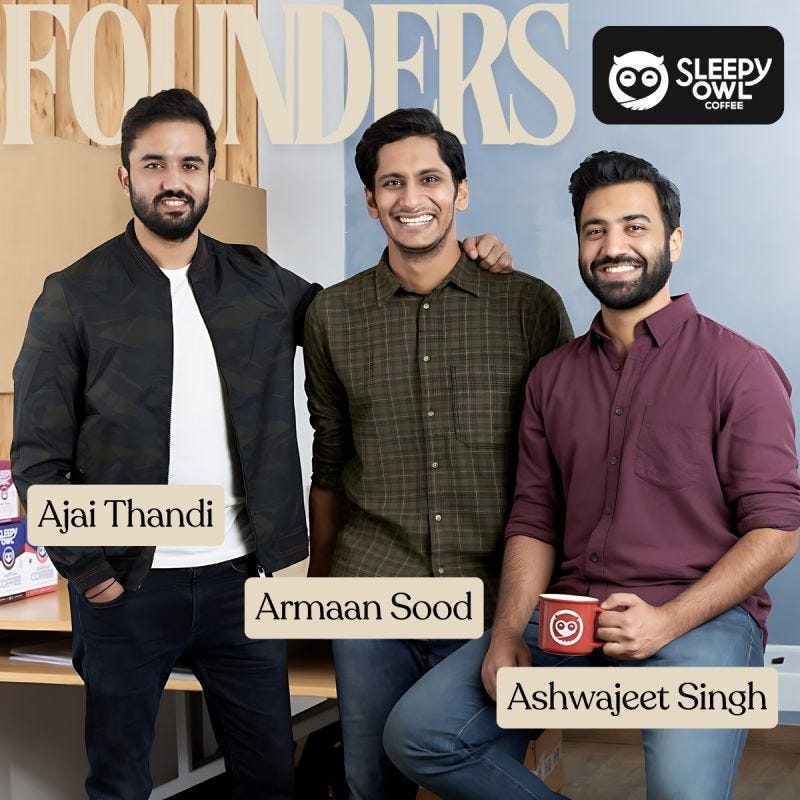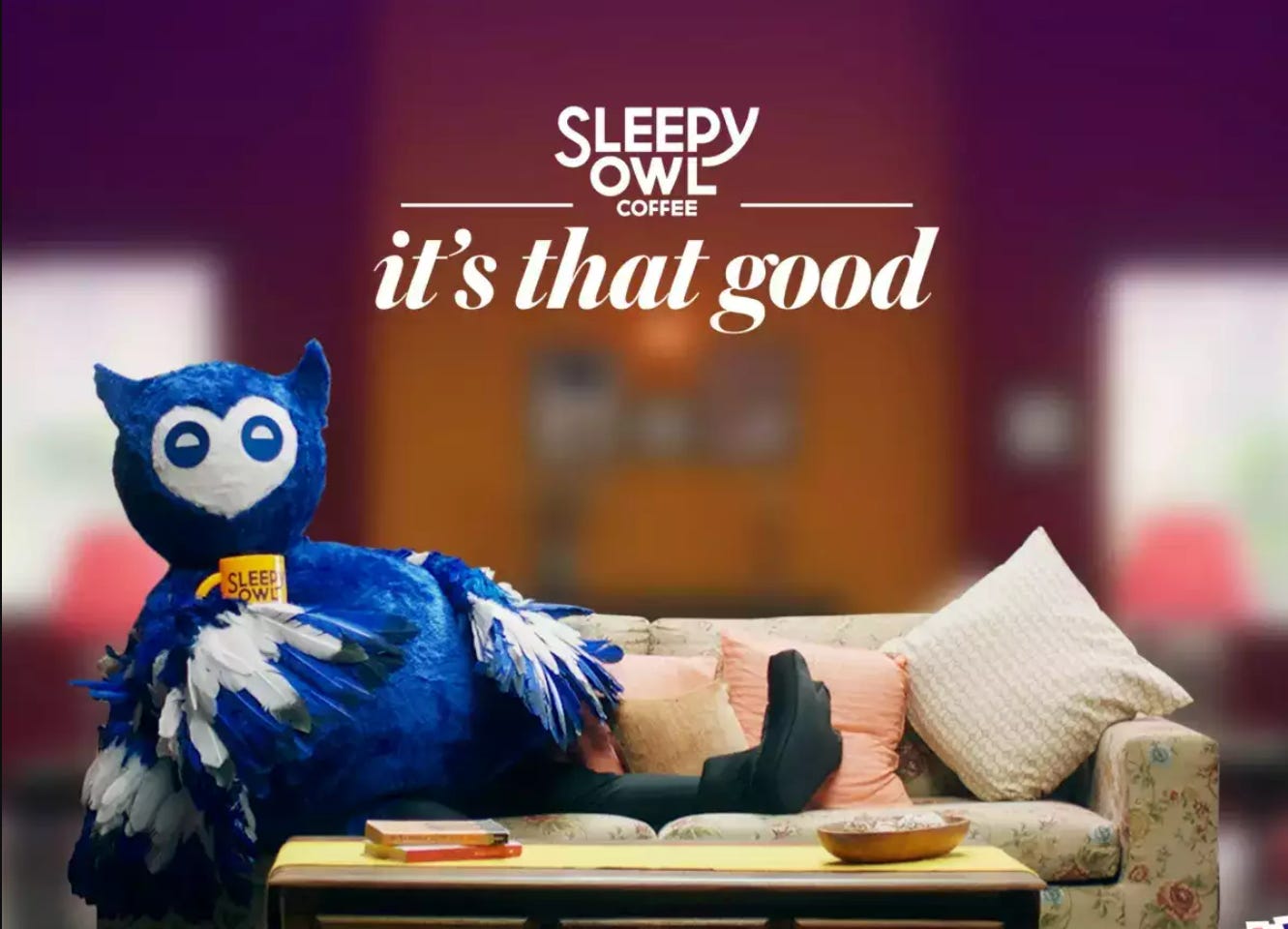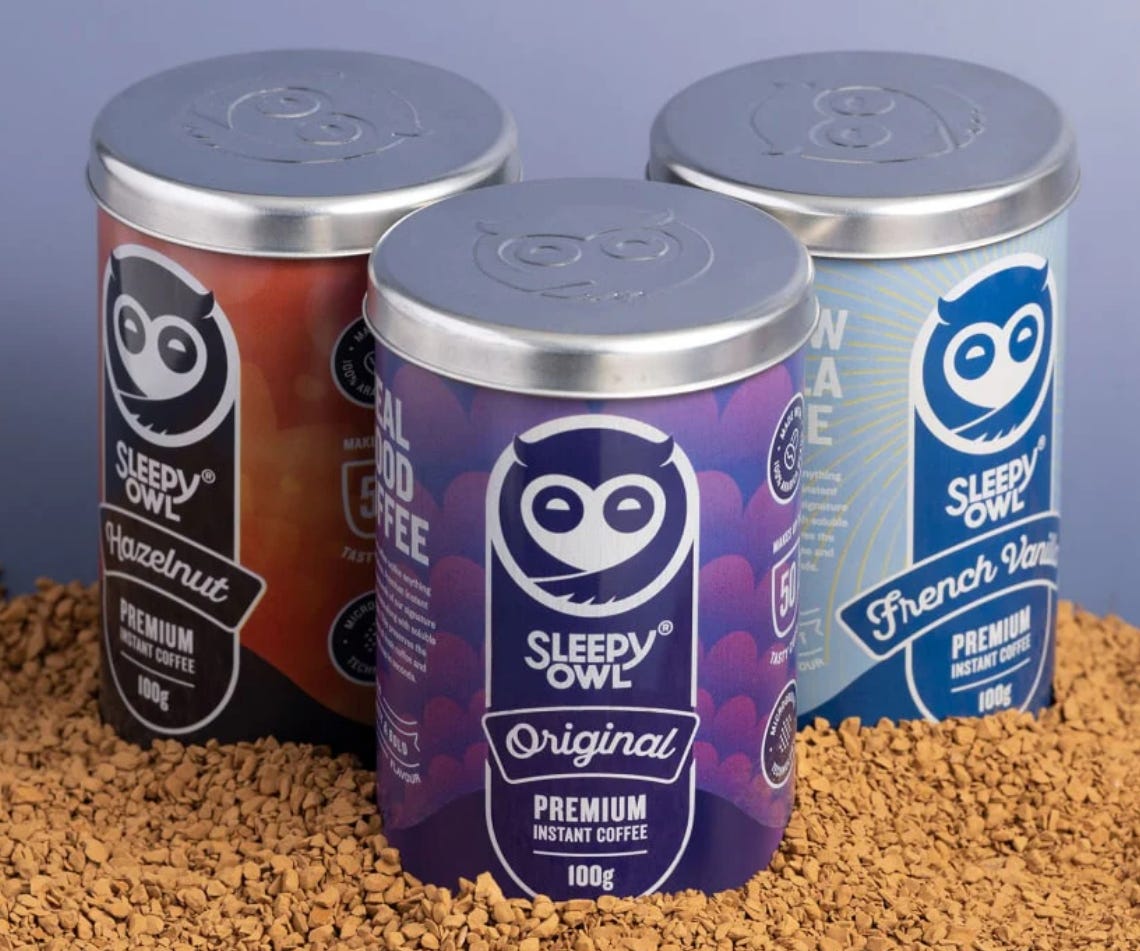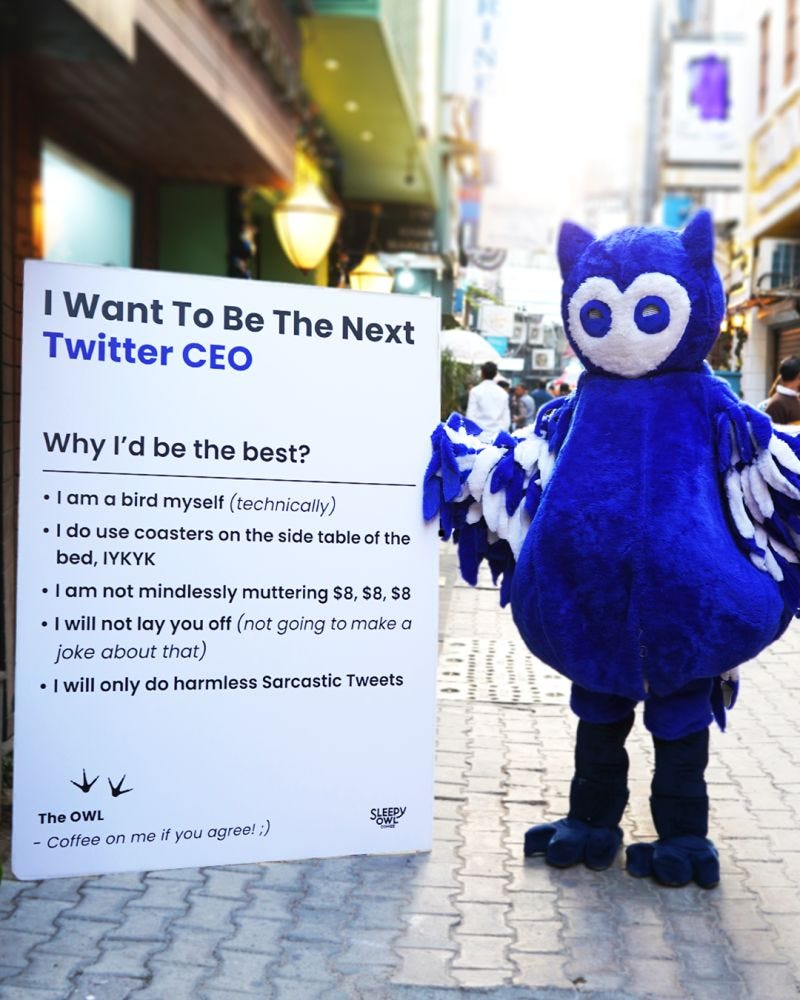Sleepy Owl Case Study: How Sleepy Owl Kept India Caffeinated and Curious
The Owl That Outwitted Chai: Sleepy Owl’s Journey to Coffee Supremacy
India is a country of chai. With over 837,000 tonnes of tea consumed annually, tea isn't just a beverage here—it's an integral part of the culture. Whether it's a cup shared at a roadside stall or brewed at home, tea has been the drink of choice for generations. It brings people together, sparks conversations, and is embedded in every social ritual.
Consumption volume of tea in India from the financial year 2015 to 2022 (in a million kilograms)
For decades, coffee remained in the shadows, largely confined to instant blends or the occasional visit to an upscale café. While brands like Nescafe and Cafe Coffee Day introduced coffee to urban India, they still couldn't dethrone tea’s reign. The coffee market, though growing, remained small in comparison.
And then there’s cold brew—a segment virtually unheard of in the Indian market, where even seasoned coffee drinkers preferred their brew hot. For a country rooted in its tea traditions, the idea of cold coffee was far from mainstream. It wasn’t just about taste preferences—it was about challenging deeply ingrained habits.
The Entry of Sleepy Owl: Brewing a New Coffee Culture
In a country steeped in the tradition of tea, the idea of cold brew coffee seemed almost radical. But against all odds, Sleepy Owl entered the market and not only introduced a niche product but redefined how young, urban India thought about their daily caffeine fix.
Sleepy Owl wasn’t born in a boardroom or backed by seasoned coffee veterans. It was the brainchild of three friends—Arman Sood, Ajai Thandi, and Ashwajeet Singh—who saw an opportunity where others saw obstacles. None of them came from the coffee industry, but they shared a simple frustration: why wasn’t there a great, ready-to-drink cold brew option in India? This question led them down an entrepreneurial path they hadn’t initially planned for.
With Arman having a law degree from Jindal Global Law School, Ajai with a finance background from Northeastern University, and Ashwajeet from Delhi University, none of them seemed destined for the coffee business. Yet, this diverse mix of backgrounds proved to be their strength. They weren’t confined by the norms of the food and beverage industry, allowing them to approach the market with fresh eyes.
Before Sleepy Owl, their entrepreneurial experience was limited. They weren’t serial founders with a string of startups behind them. Instead, they were three friends with a shared belief: India’s young, urban population was ready for a new kind of coffee experience. They saw the rising coffee culture in cafes but realized that no one was serving this growing trend at home—especially with cold brew.
But starting a business wasn’t easy. From figuring out how to source quality coffee beans to perfecting the brewing process, they were learning on the go. The trio hit their share of roadblocks—supply chain issues, educating a market where chai was king, and convincing customers that cold brew could be their go-to drink.
How Did They Do It?
In a market where tea is king and coffee had always been an afterthought, how does a brand come in and carve out a space for itself—especially with something as niche as cold brew coffee? With the odds stacked against them, the question isn’t just whether they succeeded, but how they managed to pull off the impossible.
Like many other D2C brands, Sleepy Owl ticked all the boxes—nailing product-market fit, adopting a direct-to-consumer model, and creating a unique brand identity.
What did they do differently? How did they break through a market dominated by chai and international coffee giants? It wasn’t just about the product; it was about creating a shift in perception, tapping into a new generation of consumers, and building an experience that went beyond just a cup of coffee.
While other brands relied on sleek designs or catchy slogans, Sleepy Owl’s wide-eyed owl mascot became much more than just a logo. It symbolized alertness, wisdom, and the hustle of urban millennials—appealing directly to a generation burning the midnight oil. Whether it was through their website, social media, or packaging, the owl represented staying sharp and ready for whatever the day (or night) threw at you.
Packaging with Personality
Sleepy Owl didn’t just stick their mascot on the packaging for decoration. They made it the star of the show. By featuring the sleepy owl prominently on each coffee pack, they turned their packaging into a conversation starter. Customers began associating the cute owl with premium coffee, and this unique identity helped them stand out in a market flooded with similar products. In fact, after redesigning their packaging, Sleepy Owl saw a 20% increase in customer recall—proving that a well-designed mascot can make a brand unforgettable.
Social Media: Where the Owl Took Flight
Sleepy Owl took their mascot beyond packaging and made it a central figure in their social media presence. Whether through quirky memes or playful customer interactions, the owl brought a personality to the brand that audiences loved. Social media posts featuring the owl consistently saw 15-20% higher engagement rates compared to other content. With over 80,000 Instagram followers, Sleepy Owl’s mascot-driven approach helped them build a loyal online following, making their brand not just visible but lovable.
Merchandise and Offline Visibility
The owl wasn’t just an online sensation—it became a real-world icon. Sleepy Owl launched limited-edition owl-themed merchandise that quickly sold out, giving fans a tangible way to connect with the brand. The demand for these products spiked website traffic by 30% as customers rushed to grab their own piece of Sleepy Owl. The mascot also made appearances in in-store displays and pop-up events, becoming a familiar face in the local coffee scene. By turning their mascot into a symbol of the brand, Sleepy Owl created an experience that extended beyond the product.
Collaborations and Pop-Ups: Bringing the Owl to Life
Sleepy Owl’s owl wasn’t just confined to packaging or social media; it came to life in collaborations and pop-up events. By partnering with local cafes and hosting events where the owl played a starring role, they were able to create a playful and memorable experience for customers. These collaborations led to a 40% increase in foot traffic at pop-up locations, proving that the owl had the power to draw people in. Whether online or offline, the mascot became a visual cue that customers couldn’t ignore.
Interactive Campaigns: Engaging the Community
Sleepy Owl went a step further by involving their audience directly with interactive campaigns. They encouraged customers to share fan art or creative photos of their products, with the owl always front and center. These campaigns resulted in a 25% boost in user-generated content and a 15% increase in brand mentions across social media. By turning their audience into co-creators, Sleepy Owl deepened their connection with the community and solidified the owl’s place in the brand’s story.
A Brand Icon That Stands Out
In an era where sleek minimalism is often the norm, Sleepy Owl embraced fun and creativity through their mascot. The sleepy-eyed owl wasn’t just a cute figure; it embodied the brand’s core values of convenience, quality, and personality. Through smart use of their mascot in packaging, social media, offline events, and interactive campaigns, Sleepy Owl created a brand that people not only recognized but genuinely loved. And the numbers speak for themselves—this little owl helped Sleepy Owl carve out a loyal customer base in a competitive market.
From Bootstrap to Boom: Sleepy Owl's Rapid Growth Journey
Sleepy Owl began its journey with an initial investment of ₹50 lakhs ($67,000), targeting a gap in India’s coffee market. Their vision quickly attracted investors, and by 2018, they secured ₹3.5 crores ($500,000) in seed funding led by DSG Consumer Partners. This capital allowed the brand to scale its operations and expand its product line. Sleepy Owl's growth trajectory continued, and in 2021, they raised ₹60 crores ($8 million) in Series A funding, helping them penetrate deeper into retail and ramp up production.
As of 2022, the company has clocked ₹1,33.5 crore ($16M million) in annual revenue, solidifying its place as a leading D2C coffee brand in India. What started as a small operation now boasts over 100 employees and a retail presence in 1,500 stores nationwide, including premium outlets like Nature’s Basket and Modern Bazaar. Sleepy Owl’s online strategy also paid off, with their products becoming a favorite among urban millennials, backed by a strong social media presence with 80,000 Instagram followers.
KLUBZERO Analysis
Sleepy Owl’s journey from a niche cold brew startup to a ₹1,33.5 crore ($16M million) brand demonstrates the power of a strong mascot and cohesive brand identity. It wasn’t just about selling coffee—it was about creating a connection with consumers that went beyond the product. Much like Amul’s iconic Girl or Vodafone’s ZooZoos, Sleepy Owl’s mascot helped build an emotional bond, boosting brand recall by up to 25%. Their consistent use of the owl across platforms—from packaging to social media—created a cohesive brand experience, leading to a 20% increase in customer recall and 15-20% higher engagement on social media. Sleepy Owl didn’t stop there; they actively involved their community with interactive campaigns and offline pop-ups, resulting in a 25% rise in user-generated content and a 30% spike in website traffic during merchandise launches. By blending product innovation with a thoughtful brand strategy, Sleepy Owl created a brand that resonates emotionally with its audience, proving that a well-crafted brand identity can make all the difference in standing out in a competitive market.















